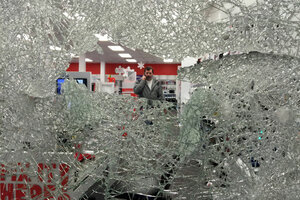Why Eric Garner protests in Berkeley are particularly hard to control
While police tried a range of crowd-control methods, the sorts of spontaneous demonstrations sparked by the Eric Garner and Michael Brown cases are very challenging from a community policing perspective, experts say.

In this photo provided by Gabriel Reyes, a man talks on the phone at a Radio Shack that was vandalized overnight in Berkeley, Calif., as protesters angered by police killings in Missouri and New York demonstrated in the streets.
Gabriel Reyes/AP
Los Angeles
As protests over the Eric Garner grand jury decision continue to spread, the college town of Berkeley erupted over the weekend in two nights of activism punctuated by violent vandalism.
How and when the police responded in this city of some 100,000 residents is providing a useful snapshot of how law enforcement still faces serious challenges in handling spontaneous, violent protests, say police and criminal justice experts as well as activists themselves.
Despite Berkeley’s decades-long tradition of political protests, the city’s law enforcement was little better prepared to deal with random violence during the protests than other small town police departments such as Ferguson, Mo., says Philip Stinson, assistant professor in the criminal justice program at Bowling Green State University in Ohio.
“My sense is that this is an ongoing problem of police training, and there is always a new generation coming along,” he says.
Beyond that, he adds, the sorts of spontaneous demonstrations sparked by the Garner and Michael Brown cases are very challenging from a community policing and planning perspective.
“It’s one thing when you’re dealing with a major city such as Washington or New York, where protesters have permits and there are leaders and organizers the police can talk to,” Professor Stinson says. “There is all sorts of stuff that can go on in terms of communication and preparation.”
But handling freshly minted groups with many agendas and voices – including a small fringe with purely criminal intentions – is very difficult, he says, “especially in cities such as Berkeley where you have people coming in with no other intention than to take advantage of the moment to do bad things.”
Over the weekend, stores were smashed, fires were lit, and at least five people were arrested, at the same time as crowds of largely peaceful protesters marched through both Berkeley and neighboring Oakland, according to the Berkeley Police Department.
Throughout the two-day spree, police responded with tactics ranging from tear gas, batons, and paramilitary tanks and guns with rubber bullets to less aggressive strategies such as channeling the direction of the march and splitting the groups into smaller crowds.
The various tactics did little to prevent the escalating violence and looting throughout the weekend, eyewitnesses say.
Attorney Brian Hofer followed the coverage on Saturday night and then went out on the street Sunday night as the protesters moved through the town. That night, random incidents of violence such as setting a police vehicle afire, smashing store windows, and spray-painting graffiti proliferated.
He points out that the police tactics were notably different between Saturday and Sunday nights. On Saturday, at least five mutual aid police departments joined in from nearby communities such as Alameda, Contra Costa, Oakland, and Pleasanton. This mélange provided its own lessons, he notes.
“It seemed clear that the various mutual aid agencies were not communicating with each other very well,” he says. One group was working to walk a crowd back while another was aggressively using tear gas, tanks and rubber bullets.
“It was really just sort of chaos,” he says, adding that the aggressive show of force by police Saturday night did little to calm the crowds down.
On Sunday, he said he only saw evidence of the Berkeley Police Department, who showed more restraint.
There are no easy fixes, says Tod Burke, a former Maryland police officer and professor of criminal justice at Radford University in Virginia.
He notes that in the past, protests were largely local. As social media turns even the smallest local event into a national moment, Professor Burke says, every police department from Minnesota to Florida has to be looking at cities like Berkeley and trying to figure out what they can learn and how they can apply lessons to their own unique communities.
“It used to be very localized, but now what happens in one part of the country affects the other parts as well,” he says, adding, “what works in one area may not work in another, but they have to be asking the questions.”

